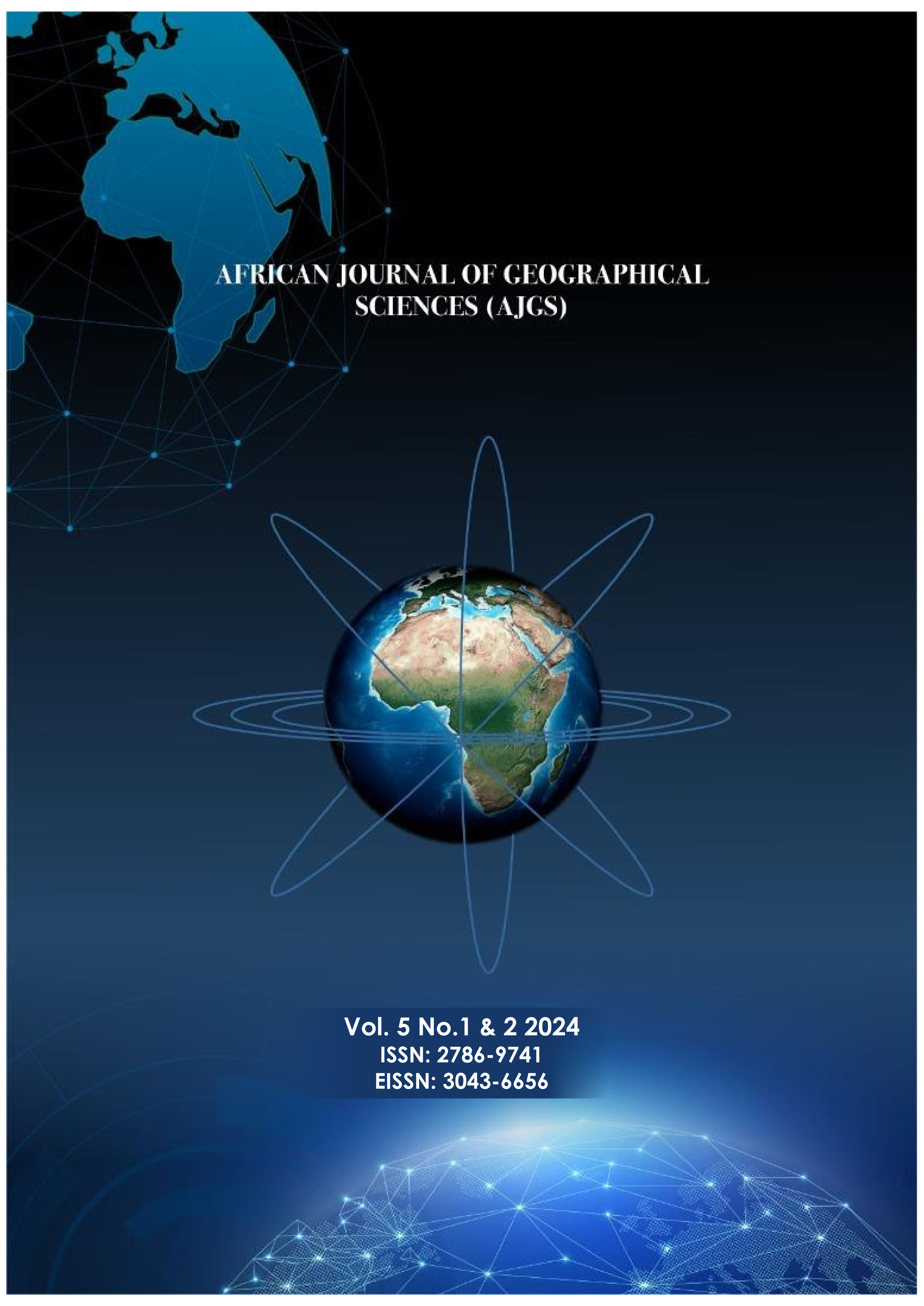Spatio-Temporal Change in Land Use, Land Cover and Land Surface Emissivity in Benin City, Edo State, Nigeria
Contenido principal del artículo
Resumen
Land use-land cover changes are adjudged as major drivers of climate change. They determine the level of Land Surface Emissivity and the consequent thermal conditions. This study examined the impacts of land use land cover change on land surface emissivity of Benin City between 1991 and 2021. It employed a geospatial technique for the data acquisition and spatial analysis. The result showed a spatio-temporal change in urban land uses which led to a remarkable loss in vegetal cover. The trend of depletion in vegetation and changes in land uses was followed by a rise in urban land surface emissivity. Thus, there was a corollary between change in land use land cover and land surface emissivity. Within the period, water body increased by 0.0088 Km2, the built-up area increased by 34.4587 Km2 while cultivated area and vegetation reduced by 2.0413 Km2 and 29.0069 km2 respectively. Findings also revealed a steady rise in
LSE within the period from a range of 0.975-0.987μm in 1991 to 0.986-0.987μm in 2006 and 0.9860.988μm in 2021. By implication, there was a progressive increase in the land surface emissivity due to changes in land use land cover within the study period. Hence, urban land use land cover dynamics lends credence to urban land surface emissivity which is a precursor to several ecological problems. It becomes necessary to adopt relevant mitigations like afforestation, use of low thermal emissive materials and effective urban planning to curb the emissions.
Detalles del artículo
Citas
Abotutu, A.A. (2016).The impact of urbanization on the vegetation of Abraka and its environs. African Journal of Environmental Studies, 2, 16-44.
Adebayo, W.O. (2007). Heat Island and Oasis, effect of vegetative canopies: A micrometeorological investigation. International Journal of Urban and Region Affairs, 1(1), 35-40.
Amer, k. Parham, P., & Behnaz, B. (2017). Land use analysis on land surface temperature in urban areas using geographically weighted
regression and land sat 8 imagery, case study: Tehran, Iran. The International Archives of Photogrammetry, Remote Sensing and Spatial Infor Sci, XLII-4/WA,
Annamaria, L., Jose AS., Drazen S. & Eric, A. (2017). The urban heat island effect in the city of Valencia: A case study for hot summer day. Journal of Urban Science. 2(1):1-18
Bolstad, P. (2002). GIS Fundamentals: A first text on Geographic Information Systems. Eider Press, White Bear Lake, 89-109
Mushkin, A., Balick, L.K. & Gillespie, A.R (2005). Extending surface temperature and emissivity retrieval to the mid-infrared (3-5 μm) using the multispectral thermal image (MTI). Journal of Remote Sensing of the Environment, 9(1), 41-45
Caselles, V., Colleagues, C., Valor, E. & Rubio, E. (1995). Mapping land surface emissivity using AVHRR data: application to La Mancha, Spain. Remote Sensing Review 12(3-4), 311-333.
Chukwuka, A. F. & Makinde, E.O. (2018). Land surface temperature mapping using geoinformation Techniques. Journal of Remote Sensing of the Env, 32(5), 86-166.
Efe, S.I. & Eyefia, A.O. (2014). Urban warming in Benin City, Nigeria. Atmospheric and Climate Sciences, 4, 241-252.
Eliasson, I. (1996). Urban nocturnal temperatures, street geometry and land use. Atmospheric Environment 30(3), 379-1379
Elise, S., Xiaopu, S. & Durwood, Z. (2010). Enhancing urban albedo to fight climate change and save energy. Journal of Sustainable Development in the Urban Environment, 11(1), 6-32
Eruotor, S. (2014). Geography made simple: senior school Geography. Tonad Publication.
Fabeka, B.B., Balogun, I.A., Adegboyega, S.A. & Faleyimu, O.I. (2018). Spatio-temporal variability in land surface temperature and its relationship with vegetation types over Ibadan, South West Nigeria. Journal of Atmosphere and Climate Sci, 8(3), 316-333
Ikhile, C.I. (2016). Geomorphology and hydrology of the Benin region, Edo State. International Journal of Geosciences, 07(02), 144-157.
Ikhuoria, A.I. (1987). Rapid urban growth and urban land use patterns in Benin City, Nigeria. Land Use Policy, 01(4), 62-75.
Lambin, F.F., & Ehrlich, D. (1996). The surface temperature-vegetation index space for land use and land cover change analysis. International Journal of Remote Sensing 17(3), 463-487.
Manat, S. Kazunori, H. & Vivarad, P. (2012). Assessing the impact of urbanization on urban thermal environment: A case study of Bangkok Metropolitan. International Journal of Applied Science and Techn, 2(7).
Meng, L., Xin, C. & Chen, X. (2016). Method of land cover classification accuracy assessment considering edges. Journal of Earth Sciences, 9(2)23-39
Obiaderi, N.U. & Thelma, E.I. (2019). Analysis of daily average temperature of Benin City using the two parameter Weibull model. Nigerian Association of Mathematical Physics, 4(19) 65-71
Odjugo, P., Enaruvbe, G. & Isibor, H. (2015). Geospatial approach to spatio-temopral pattern of urban growth in Benin City, Nigeria. African Journal of Environmental Science and Technology, 9(3), 166-175.
Okhakhu, P.A. (2016). Assessment of the urban climate of Benin City, Nigeria. Journal of Environ and Earth Science, 6(1), 131-143.
Olayiwola, A. & Igbavboa, O. (2014). Land use dynamics and expansion of the built up area in Benin City, Nigeria. Mediterranean Journal of Social Science, 5.
Spence, M., Annez, P.C. & Buckley, R.M. (2009). Urbanization and growth; World Bank, Washington. 2(3), 22-29
Surjikov, S.T. (2010). Coupled radiation, convention and conduction. Thermomedia, 2(2), 8-23
Watson, K. (1992). Spectral method for measuring emissivity. Remote sensing of the environment 42(2), 113-116
Weng, Q. (2001). A remote sensing-GIS evaluation of urban expansion and its impact on the temperature in the Zhujiang Delta, China. International Journal of Remote Sensing 22(10), 1999-2014.
World Bank Group (2021). Climate change action plan: Climate and risk disaster screening. Climate Research Unit. International Bank for Reconstruction and Development. https//www.worldbank.org/country/Nigeria/benincity
Zhao-Liang, L., Hua, W. & Ning, W. (2013). Land surface emissivity retrieval from satellite data. Journal of remote sensing, 2(4),23-45
